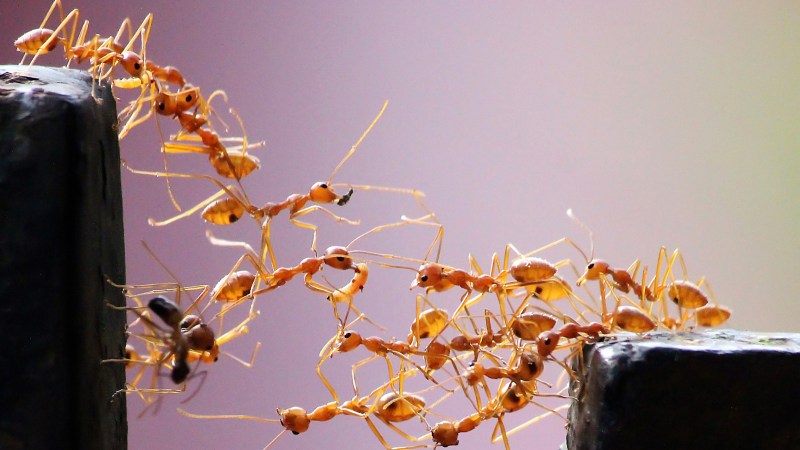Humans and insects think on a different scale, but entomologists study the behavior of these little organisms, so they’re not a complete mystery. There isn’t much intelligence in a single ant or a cubic millimeter of gray matter, but when they all start acting together, you get something greater than the sum of the parts. It is easy to fall into the trap of putting all the intelligence or programming into a single box since that’s how we function. Comparatively, itty-bitty brains, like microcontrollers and single-board computers are inexpensive and plentiful. Enter swarm mentality, and new tasks become possible.
[Kevin Hartnett] talks about a paper researching the simple rules which govern army ants who use their bodies as bridges when confronted with a gap in their path. Anyone with a ruler and a map can decide the shortest route between two places, but army ants perform this optimization from the ground, real-time, and with only a few neurons at their disposal. Two simple rules control bridge building behavior, and that might leave some space in the memory banks of some swarm robots.
A simpler example of swarm mentality could be robots which drive forward anytime they sense infrared waves from above. In this way, anyone watching the swarm could observe when an infrared light was present and where it was directed. You could do the same with inexpensive solar-powered toy cars, but we can already see visible light.
We’re not saying ants should be recruited to control robots, but we’re not objecting to the humane treatment of cyborg bugs either. We’ve been looking into swarm robots for a long time.
Thanks for the tip, [JRD].

















Thanks great article
“or a cubic millimeter of gray matter”
I know this may be shocking to you, but ants don’t have grey matter. Only mammals have neocortex, and that’s where all the grey matter is (there is some talk about parrots and crows having a functionally equivalent thing, but still pretty far from ants).
I believe that the conjunction “or” here neither states nor implies that ants do have grey matter.
It would be read as: “There isn’t much intelligence in a single ant”. followed by “There isn’t much intelligence in a cubic millimeter of gray matter”
If it’s not related to the ants, why is it mentioned at all?
I should imagine because for the typical mammal, human, for example, the sum of all of the cubic millimeters may show significant intelligence, even though a single mm^3 isn’t much. Maybe it is an analogy to draw a connection to the mostly human readers of the article? Just a guess. Maybe you can’t relate….
Cooperative behavior (flocking, etc) seems to be easier to implement than “everything in one box”.
Your comment and this article reminded me of something I read about almost 10 years ago. “Boids”: https://en.wikipedia.org/wiki/Boids
A flocking routine for that mimics the behaviour of birds.
so.. we can build HEXX? (if we can get enough bugs in….)
That was the first thing I was thinking of. No magic would even be needed. Put them in a maze that represents a problem and possible solutions then let them see which one is right.
I do remember seeing some joke ‘Anthill Inside’ stickers awhile back…
Thanks ants.
Thants.
what is this, a thanks for ants?
Sigh…
…how doesn’t EVERYONE here know about this?!?
https://www.youtube.com/watch?v=gaI6kBVyu00
I believe every episode of both seasons in available to watch on YouTube.
Swarm Intelligence is the future. Great article.